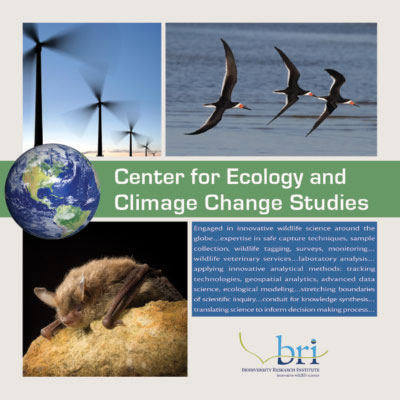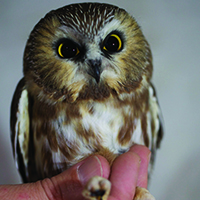Highlighted Raptors We Study

Bald Eagle
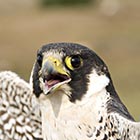
Peregrine Falcon

Osprey

American Kestrel

Merlin
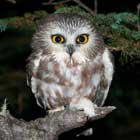
N. Saw-whet Owl

Breaking News: BRI announces the publication of a scientific paper in the journal Science, which evaluated the acute and chronic exposure of Bald Eagles and Golden Eagles to lead (Pb) at a nationwide scale. BRI’s Raptor Program Director Chris DeSorbo was among 29 co-authors of the study, which broadly evaluated lead exposure in both species across 38 U.S. states. The study, led by Vince Slabe of Conservation Science Global and Todd Katzner of the U.S. Geological Survey, detected unexpectedly high frequencies of lead poisoning in tissues reflecting both acute (blood, liver, feather) and chronic (bone) exposure to lead. Continent-scale demographic modeling suggested that lead poisoning at observed levels suppresses population growth rates in each of these charismatic and iconic raptors. Read more here.
Studying Raptors as Sentinels of Ecosystem Health
BRI studies raptors to aid in their conservation and the protection of the habitats and ecosystems in which they reside. Raptors play key ecological roles in the systems in which they feed, therefore an understanding of raptor ecology is an important way of understanding our environment. The history of the catastrophic decline and subsequent recovery in several raptors such as the Bald Eagle, Osprey, and the Peregrine Falcon, are intertwined with the enactment of some of the most important and consequential environmental policies in U.S. history such as the Endangered Species Act, the ban on DDT pesticides and the Clean Water Act.
BRI’s raptor research focuses on informing the management and conservation needs of raptors. Our research emphasizes three nonexclusive areas: (1) contaminants monitoring; (2) movement studies; and (3) population monitoring.
Contaminants Monitoring
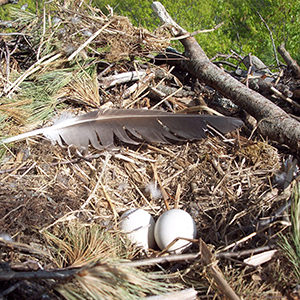
Raptors are among the most widely-known bioindicators, or
“biosentinels” of environmental health. Biologists sample birds to evaluate the potential for reproductive or behavioral impacts due to contaminant exposure. This information has proven pivotal in policy decisions to regulate pollutants.
Representative projects with a focus on monitoring contaminants in raptors:
Movement and Tracking Studies
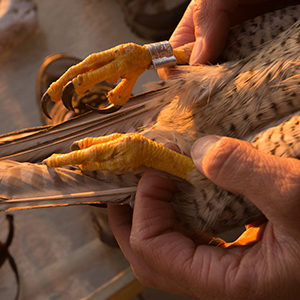
Movement studies help us gather information about raptor behavior and ecology that is critical in management and conservation decision-making. We gather information on raptor movements primarily through the banding and tracking of captured individuals
Representative projects with a focus on tracking raptors:
- Studying movement patterns and wintering area use of raptors migrating along the U.S. Atlantic Flyway using the Block Island Raptor Research Station (and others).
- Tracking the Range and Migration Routes of New Hampshire Peregrine Falcons
- Characterizing habitat use and dispersal patterns of Maine adult and subadult Bald Eagles using satellite telemetry and color banding
Surveys and Population Monitoring

Conservation biologists collect information needed to detect and measure changes in the stability of raptor populations. We survey raptor populations to document the number of individuals, breeding pairs, nonbreeding pairs, nests, and young produced in an area.
Representative projects with a focus on raptor surveys and population monitoring:
- Quantifying the use of New England’s premier fish run by Bald Eagles
- Characterizing the diurnal and nocturnal raptor migration at Monhegan Island, Maine
- Evaluating Osprey Nest Abundance, Distribution and Productivity in Casco Bay
- Tracking Northern Saw-whet Owls along the coast of Maine
LEARN MORE about other BRI Inventory and Population Studies >

BRI’S RESEARCH PUBLISHED IN THE JOURNAL SCIENCE
BRI researchers have joined scientists around the world in a landmark study published in the journal Science that uses three decades of animal tracking data to gather insights about animal responses to changing environmental conditions in the Arctic. The study, titled Ecological insights from three decades of animal movement tracking across a changing Arctic, utilizes and broadly introduces the Arctic Animal Movement Archive (AAMA). The AAMA is an active collection of tracking datasets from researchers across the globe for marine and terrestrial animals in the arctic.
Also, check out the Arctic Animal Movement Archive (AAMA) on Movebank here, and explore other exciting, related links here.
Photo Credits: Header photo: © Daniel Poleschook. Study Subjects: Bald Eagle © Sharon Fiedler; Peregrine Falcon © Ken Wright; American Kestrel © iStock; Merlin © Ken Wright; Northern Saw-whet Owl © BRI-Chris DeSorbo. Eagle on Branch: © Daniel Poleschook. Special Section: Peregrine Falcon © BRI-Alex Dalton. Eagle nest © BRI-Chris DeSorbo. General content: Banding BRI-Chris DeSorbo. Peregrine with sat tag BRI-Jonathan Fiely. Sea plane © Ken Wright. Merlin in can © Ken Wright.

